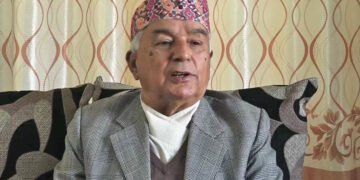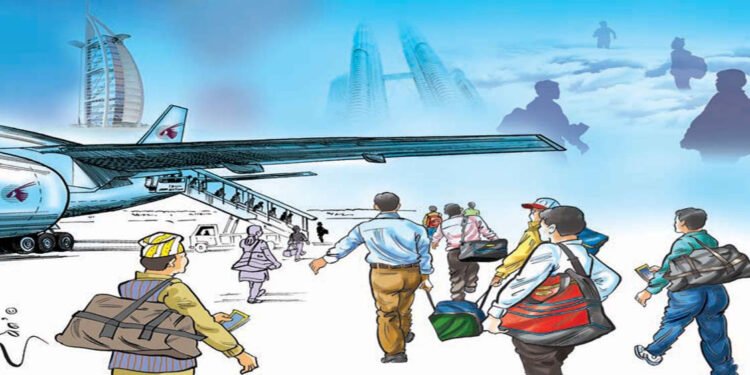Kathmandu, Oct 19: Nepali youth are increasingly forced into foreign employment opportunities due to factors such as political instability, rising unemployment, and corruption within political parties. This trend is concerning for a nation of which youth are considered the backbone of the country. The role of the youth is crucial for the development of a country, and but sadly, many Nepali youth, despite their qualifications and skills, are compelled to leave their homeland in search of better opportunities abroad.
Shrinking villages and barren fields
Nepal is witnessing a significant demographic shift as villages and cities alike are being depopulated. Agriculture, once the mainstay of the rural economy, is in decline, with fields lying barren and livestock barns falling apart. Just 16 years ago, only about 3,000 young people left Nepal annually in search of work; today, this number has skyrocketed to nearly 300,000. Around 3.2 million Nepalis are currently employed legally or illegally in the Gulf and other Middle East countries. Annually, Nepal generates a labor force of around 400,000, and foreign employment has become the preferred option for most of them.
According to the Department of Immigration, 70,915 Nepali youths left the country for work abroad in 2023 alone. On average, 1,500 to 2,500 youths depart daily. The International Labour Organisation (ILO) estimates that over 500,000 Nepali youths leave the country annually, with only 15% being skilled, 25.5% semi-skilled, and 74.5% unskilled. This exodus of youth is a stark reminder that many are forced to sell their labor abroad due to the lack of opportunities at home.
Youth disillusionment and political instability
The once enthusiastic and hopeful faces of youth who fought for political change in Nepal are now turning to foreign lands for survival. The lack of leadership opportunities, coupled with unstable politics and corrupt practices, has disillusioned many. Nepali youth are increasingly losing faith in the country’s political and economic systems, with political parties often exploiting their potential for their own gain rather than nurturing their talents for national development.
Lack of employment and economic instability
Nepal’s youth possess skills, energy, and perseverance, which have been recognised globally. Many Nepalis have proven their abilities abroad by contributing to foreign economies through their knowledge, hard work, and honesty. The remittances sent by these workers have strengthened Nepal’s national economy. Yet, this skilled and capable workforce has not been properly utilised within Nepal.
Employment opportunities in Nepal are scarce, with many youths unable to secure jobs that match their qualifications. Agriculture, on which many rural Nepalis rely, is becoming increasingly difficult due to outdated systems, land fragmentation, and the impacts of climate change. This has driven many to seek better prospects abroad.
Education and healthcare challenges
The quality of education and healthcare services in Nepal leaves much to be desired, prompting many Nepalis to move abroad for better opportunities. Students, in particular, are compelled to go abroad for quality education, and those suffering from serious health conditions often seek treatment elsewhere. These shortcomings in basic services continue to push Nepalis away from their homeland.
Impact of social change and modernity
Social factors also play a role in the migration of Nepali youth. The allure of a prosperous life abroad, fueled by social media portrayals of Nepalis living comfortably in foreign lands, has led many to dream of leaving Nepal. The lack of opportunities within the country, coupled with the appeal of modern lifestyles abroad, has become a significant driving force behind youth migration.
Need for policy reform
To address these challenges, Nepal must focus on creating employment opportunities, improving education and healthcare, and offering youth greater leadership roles in politics and society. Without such reforms, the trend of youth migration is likely to continue, depriving Nepal of its most valuable resource—its youth.
Industrial development is crucial to creating jobs within Nepal. The establishment of industries would contribute to economic activities across sectors, from raw material production to the manufacturing of finished goods. However, Nepal’s current economic policies are not conducive to fostering industrial growth, and foreign investment remains minimal. Instead of developing local industries, Nepal has become a hub for foreign goods, which has further reduced job opportunities.
Conclusion
The mass exodus of Nepali youth is a pressing issue that needs immediate attention. The lack of employment, poor educational and healthcare systems, and political instability are pushing Nepalis abroad. Until these issues are addressed, the trend is unlikely to reverse. Policymakers must conduct a thorough review of the situation and implement effective reforms to prevent Nepal from losing its youth to foreign lands. Otherwise, the country risks becoming a beautiful but aging nation, devoid of its young and vibrant population.





















